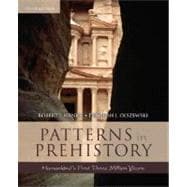
Note: Supplemental materials are not guaranteed with Rental or Used book purchases.
Purchase Benefits
What is included with this book?
| Preface | xii | ||||
| Chapter 1: Prehistory, History, and Archaeology | 1 | (40) | |||
|
2 | (3) | |||
|
5 | (6) | |||
|
11 | (1) | |||
|
12 | (20) | |||
|
32 | (9) | |||
| Chapter 2: Fundamentals of Archaeology | 41 | (42) | |||
|
41 | (2) | |||
|
43 | (14) | |||
|
57 | (8) | |||
|
65 | (7) | |||
|
72 | (11) | |||
| Chapter 3: The Origins of Culture | 83 | (49) | |||
|
83 | (1) | |||
|
84 | (13) | |||
|
97 | (18) | |||
|
115 | (7) | |||
|
122 | (10) | |||
| Chapter 4: The Origins of Homo sapiens sapiens | 132 | (62) | |||
|
133 | (12) | |||
|
145 | (12) | |||
|
157 | (15) | |||
|
172 | (7) | |||
|
179 | (15) | |||
| Chapter 5: The First Americans | 194 | (34) | |||
|
196 | (11) | |||
|
207 | (10) | |||
|
217 | (5) | |||
|
222 | (6) | |||
| Chapter 6: The Origins of Agriculture | 228 | (51) | |||
|
231 | (4) | |||
|
235 | (8) | |||
|
243 | (3) | |||
|
246 | (14) | |||
|
260 | (2) | |||
|
262 | (7) | |||
|
269 | (10) | |||
| Chapter 7: The Evolution of Complex Societies | 279 | (45) | |||
|
284 | (2) | |||
|
286 | (4) | |||
|
290 | (2) | |||
|
292 | (6) | |||
|
298 | (18) | |||
|
316 | (8) | |||
| Chapter 8: Origins of Complex Societies in Southwest Asia | 324 | (44) | |||
|
325 | (3) | |||
|
328 | (1) | |||
|
329 | (5) | |||
|
334 | (7) | |||
|
341 | (8) | |||
|
349 | (7) | |||
|
356 | (2) | |||
|
358 | (10) | |||
| Chapter 9: The Origins of Complex Societies in Egypt | 368 | (37) | |||
|
370 | (3) | |||
|
373 | (2) | |||
|
375 | (2) | |||
|
377 | (7) | |||
|
384 | (1) | |||
|
385 | (4) | |||
|
389 | (2) | |||
|
391 | (4) | |||
|
395 | (1) | |||
|
396 | (9) | |||
| Chapter 10: The Evolution of Complex Societies in the Indus Valley | 405 | (27) | |||
|
407 | (2) | |||
|
409 | (2) | |||
|
411 | (1) | |||
|
412 | (3) | |||
|
415 | (7) | |||
|
422 | (2) | |||
|
424 | (8) | |||
| Chapter 11: The Evolution of Complex Societies in China | 432 | (24) | |||
|
434 | (1) | |||
|
435 | (2) | |||
|
437 | (3) | |||
|
440 | (3) | |||
|
443 | (2) | |||
|
445 | (4) | |||
|
449 | (2) | |||
|
451 | (5) | |||
| Chapter 12: Later Complex Societies of the Old World | 456 | (25) | |||
|
458 | (10) | |||
|
468 | (3) | |||
|
471 | (4) | |||
|
475 | (6) | |||
| Chapter 13: The Evolution of Complex Societies in Mesoamerica | 481 | (52) | |||
|
484 | (1) | |||
|
485 | (1) | |||
|
486 | (10) | |||
|
496 | (5) | |||
|
501 | (15) | |||
|
516 | (7) | |||
|
523 | (1) | |||
|
523 | (10) | |||
| Chapter 14: The Evolution of Complex Societies in Andean South America | 533 | (32) | |||
|
536 | (1) | |||
|
537 | (1) | |||
|
538 | (1) | |||
|
539 | (7) | |||
|
546 | (3) | |||
|
549 | (3) | |||
|
552 | (2) | |||
|
554 | (1) | |||
|
554 | (3) | |||
|
557 | (1) | |||
|
558 | (7) | |||
| Chapter 15: Early Cultural Complexity in North America | 565 | (36) | |||
|
568 | (1) | |||
|
569 | (14) | |||
|
583 | (11) | |||
|
594 | (7) | |||
| Chapter 16: Prehistory in Perspective | 601 | (10) | |||
|
601 | (5) | |||
|
606 | (3) | |||
|
609 | (2) | |||
| Art Credits | 611 | (4) | |||
| Index | 615 |
The New copy of this book will include any supplemental materials advertised. Please check the title of the book to determine if it should include any access cards, study guides, lab manuals, CDs, etc.
The Used, Rental and eBook copies of this book are not guaranteed to include any supplemental materials. Typically, only the book itself is included. This is true even if the title states it includes any access cards, study guides, lab manuals, CDs, etc.